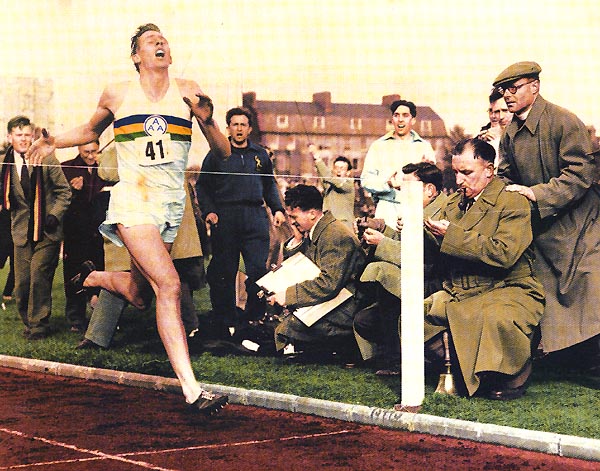

In 1952 a young English runner named Roger Gilbert Bannister found himself in the 1500m final. The race was to prove one of the most dramatic in Olympic history, and the outcome was not decided until the final metres. Bannister finished a disappointing fourth. Over the next two months Bannister considered a number of dramatic changes to his training; and even the idea of giving up running altogether.
To say he was frustrated is an understatement. Ultimately, he decided on a new goal – he would run a mile in less than four minutes. At that time, nobody had ever achieved this. In fact, this was several seconds faster than the world record. Over the next couple of years he gradually took slices off his times. By the start of 1954 he was running a mile in just over 4min2secs. The day that was to change his life came in May 1954, during a meet in Oxford. In front of 3,000 incredulous spectators, Bannister ran the mile in 3min 59.4sec. He had finally done it.
A new way of thinking
The astonishing part is not just Bannister’s achievement (although that’s a big thing in itself); it’s how quickly other runners were breaking the same barrier. Just 46 days later – in a meet in Turku, Finland – Australian John Landy broke the record with a 3m57.9s . Others soon followed. This to me outlines the power of a mental barrier to limit goals; particularly when it comes to fitness. The fact that something hasn’t been done certainly doesn’t mean it can’t be done. It also highlights the importance of putting hard numbers in the goal. Whenever I’ve tried to ‘lose a few kilos‘, ‘increase my overall strength‘, ‘run without gasping for breath‘ I’ve seen slight improvements at best. Aiming to ‘lose 10kg‘, ‘deadlift 200kg‘ etc has proven far more effective.
Defining your fitness goals
Let’s face it, most of us want to change ourselves physically in some way. Lose a few pounds, add a bit of muscle; become obscenely strong. Perhaps a combination of all three. When you’re setting your fitness goals, try using Bannister’s approach. This means :
- Start with the endpoint – your ideal weight, size or the amount you’d like to lift. This is irrespective of your current state.
- Once you’ve got an idea of the target, work out how you’re going to get there. Clean up your diet, set aside some time in the home gym; whatever you need. This will give you an idea of how long it will take.
- Put some firm numbers into the goal. Aim to reach a weight of xkg, or lift ykg.
- Finally, put a date in the goal; but be flexible. In Bannister’s case, the date was defined by the times of other competitors. By the start of 1954, he knew that his available time was fast running out.
Taking away the limits
The critical part of this comes right at the beginning, when you’re first thinking about your ultimate goal. Your ideal weight, size, strength etc. By taking away the mental barriers (such as ‘I’ve never done this before‘), it’s possible to be extremely ambitious. Aim high. The benefits of doing it this way can be enormous. After all, it’s much more fun to be near a lofty goal than a conservative one. As a bonus, many of those limitations will suddenly disappear.
Final thoughts on the Bannister Approach to Goal-Setting
Roger Bannister’s unlimited, blue sky thinking can be applied to almost any bout of goal setting. However, I’ve found this method most effective when it comes to defining physical changes; such as losing weight or packing on the muscle. It’s a great way to begin any serious transformation.










